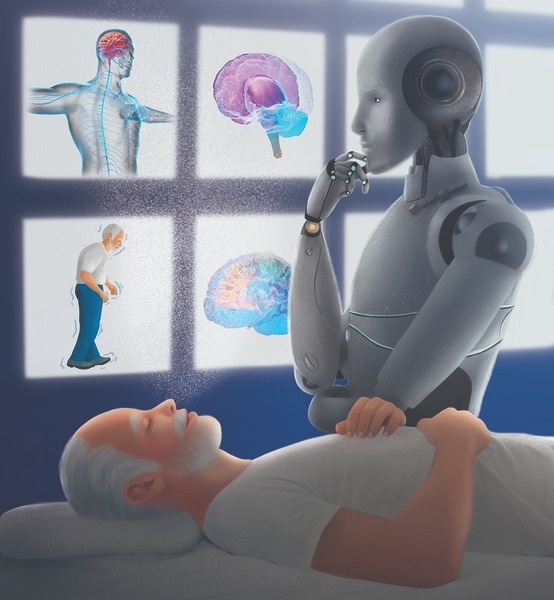Relying mainly on the advent of motor symptoms such as stiffness, slowness, and tremors, Parkinson’s disease is highly challenging to detect. However, these symptoms usually occur after many years of disease onset.
 A new neural network trained by MIT PhD student Yuzhe Yang and postdoc Yuan Yuan assesses whether or not someone has Parkinson’s from their nocturnal breathing. Image Credits: Researchers of Massachusetts Institute of Technology
A new neural network trained by MIT PhD student Yuzhe Yang and postdoc Yuan Yuan assesses whether or not someone has Parkinson’s from their nocturnal breathing. Image Credits: Researchers of Massachusetts Institute of Technology
At present, Dina Katabi, the Thuan (1990) and Nicole Pham Professor in the Department of Electrical Engineering and Computer Science (EECS) at MIT and principal investigator at MIT Jameel Clinic, and her group have programmed an artificial intelligence model to diagnose Parkinson’s by simply reading the breathing patterns of a person.
The tool in discussion is a neural network, a series of connected algorithms that imitate how a human brain functions. It can test if a person has Parkinson’s from their nocturnal breathing, which is the breathing patterns at sleep.
The neural network can also discern the severity of a person’s Parkinson’s disease and follows the disease’s progression over time. It was trained by MIT’s Yuzhe Yang, PhD student, and Yuan Yuan, postdoc.
A new paper explaining the study is published in Nature Medicine, for which Yang is the first author. Katabi is the senior author who is also an affiliate of the MIT Computer Science and Artificial Intelligence Laboratory and director of the Center for Wireless Networks and Mobile Computing.
They are collaborated by Yuan and 12 co-workers from Rutgers University, the University of Rochester Medical Center, the Mayo Clinic, Massachusetts General Hospital, and the Boston University College of Health and Rehabilitation.
Through these years, scientists have examined the capacity of diagnosing Parkinson’s with the help of cerebrospinal fluid and neuroimaging. However, these methods are expensive, invasive, and need entry to dedicated medical centers, making them unfit for recurrent assessments that are otherwise capable of offering quick detection or uninterrupted tracking of disease progression.
The MIT scientists proved that the artificial intelligence examination of Parkinson’s could be done at home every night when someone is sleeping and without touching his or her body. To perform this, they developed a tool.
It looked like a home Wi-Fi router, but instead of giving internet connectivity, the device releases radio signals, examines their reflections off the neighboring environment, and gets a person's breathing patterns without touching him or her. To test Parkinson’s passively, the breathing signal is then inputted into the neural network. Also, there is no effort required from the caregiver or patient.
A relationship between Parkinson’s and breathing was noted as early as 1817, in the work of Dr James Parkinson. This motivated us to consider the potential of detecting the disease from one’s breathing without looking at movements. Some medical studies have shown that respiratory symptoms manifest years before motor symptoms, meaning that breathing attributes could be promising for risk assessment prior to Parkinson’s diagnosis.
Dina Katabi, Study Senior Author and Affiliate, Computer Science and Artificial Intelligence Laboratory, Massachusetts Institute of Technology
Katabi is also the director of the Center for Wireless Networks and Mobile Computing.
After Alzheimer’s disease, Parkinson’s is the second-most common neurological disorder and the fastest-growing neurological disease globally. It affects more than 1 million people in the United States alone and has an annual economic burden of $51.9 billion. Including 757 Parkinson’s patients, the research team's algorithm was tested on 7,687 people.
Katabi highlights that the study has key inferences for drug development and clinical care of Parkinson’s.
“In terms of drug development, the results can enable clinical trials with a significantly shorter duration and fewer participants, ultimately accelerating the development of new therapies,” Katabi adds.
“In terms of clinical care, the approach can help in the assessment of Parkinson’s patients in traditionally underserved communities, including those who live in rural areas and those with difficulty leaving home due to limited mobility or cognitive impairment,” she states.
We’ve had no therapeutic breakthroughs this century, suggesting that our current approaches to evaluating new treatments is suboptimal.
Ray Dorsey, Study Co-Author and Professor, Neurology, University of Rochester
Dorsey is also a Parkinson’s specialist. He says that the study is a significant sleep study of Parkinson’s.
We have very limited information about manifestations of the disease in their natural environment and [Katabi’s] device allows you to get objective, real-world assessments of how people are doing at home. The analogy I like to draw [of current Parkinson’s assessments] is a street lamp at night, and what we see from the street lamp is a very small segment … [Katabi’s] entirely contactless sensor helps us illuminate the darkness.
Ray Dorsey, Study Co-Author and Professor, Neurology, University of Rochester
This study was conducted in association with the University of Rochester, Mayo Clinic, and Massachusetts General Hospital, and is funded by the National Institutes of Health, with partial funding by the National Science Foundation and the Michael J. Fox Foundation.
Journal Reference:
Yang, Y., et al. (2022) Artificial intelligence-enabled detection and assessment of Parkinson’s disease using nocturnal breathing signals. Nature Medicine. doi.org/10.1038/s41591-022-01932-x.